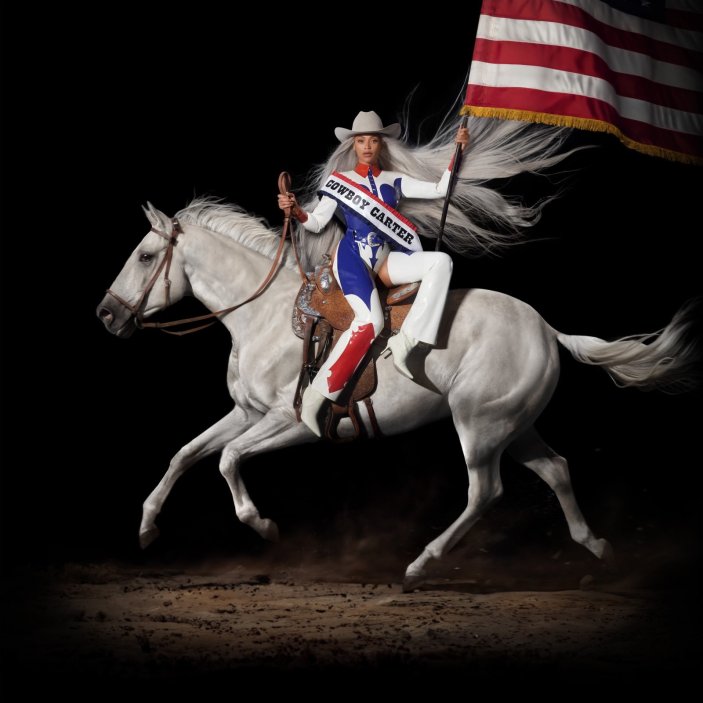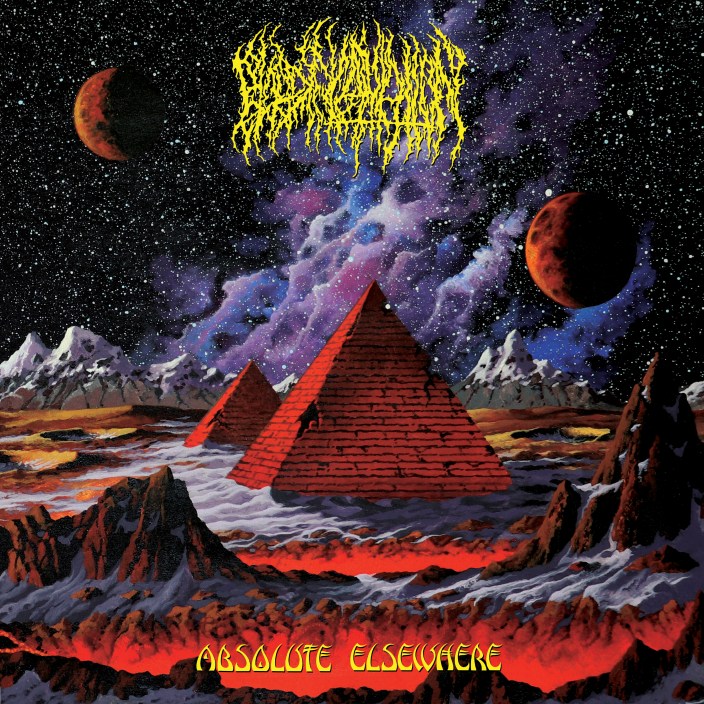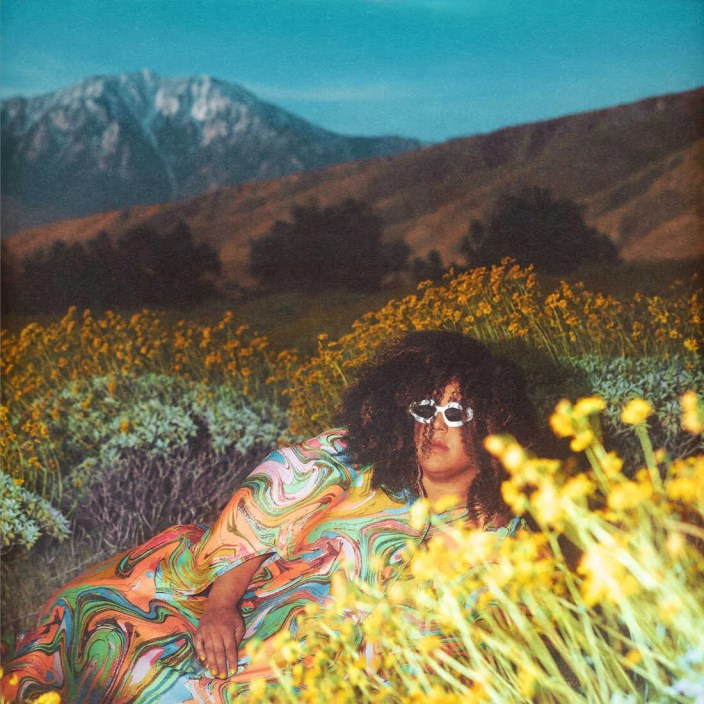
There are times when you really shouldn’t judge a book by its cover. The covers for the Neapolitan Novels by Italian writer Elena Ferrante look like straight-up stock imagery, but Ferrante’s prose and narrative prowess are unmatched. They don’t exactly speak to the quality of writing within them. With records, you can make a similar argument. I can think of several incredible records with horrendous, even off-putting artwork, like the clumps of hair on Dry Cleaning’s Stumpwork or the horrifying alien mask on M83’s Fantasy. But when an album does have a great cover, it stands out. When that cover’s visually representative of the music itself, it stands out even more.
Below is a list of some of the most notable album covers of 2024. Some caused controversy; some are laughably simple; some were outright painful to create; some are incredibly intricate. Each of the covers below is iconic in its own way.
Beyoncé — Cowboy Carter
For Act II of Beyoncé’s trilogy, which started with 2022’s house and ballroom-indebted Renaissance, the pop powerhouse becomes a rodeo queen bee. The album cover of Cowboy Carter, Bey’s foray into country, makes this plainly apparent. It portrays Beyoncé riding atop a white horse, saddle in one hand, oversized American flag in the other, covered from head to toe in red, white, and blue regalia. A sash, reading “COWBOY CARTER,” cuts across her torso. Blair Caldwell’s photograph makes Beyoncé’s homage clear. She pays tribute to a historically Black genre that’s seldom been recognized by white Nashville institutions. With its cover, Bey intends to reclaim its lineage and contribute to its present form.
Billie Eilish — Hit Me Hard And Soft

The artwork for Billie Eilish’s third album, shot by photographer William Drumm, shows the pop titan submerged underwater, looking up at an open door right beneath the surface. It’s a tidy analogue for Eilish’s signature sound: sparse, muted drum beats; woozy synths; and barely audible vocals. On Hit Me Hard And Soft, though, her voice occasionally rises to a scream, breaking free from the suffocating waters, making herself heard. It was a long, grueling photoshoot, according to Eilish’s own account, but it resulted in one of the most striking album covers of the year.
Blood Incantation — Absolute Elsewhere

Steve Dodd, the artist who painted the cover of Blood Incantation’s Absolute Elsewhere, is not an easy man to get in touch with. When I spoke with Paul Riedl, who fronts the death metal Colorado group, he told me that Dodd has no computer, no internet, no phone, and only corresponds via snail mail. But the remote painter perfectly understands Blood Incantation’s overarching universe, and its highly detailed cover, which pops with rich colors, an interstellar expanse, and mythic imagery, is proof.
Brittany Howard — What Now

When I spoke with Brittany Howard about the influences of her second solo album, What Now, she said she drew inspiration from Akira Kurosawa’s late-period film, Dreams. That movie features some of Kurosawa’s experiments with vibrant color, such as the vignette where its protagonist enters a Van Gogh painting and meets the artist himself. The album cover for What Now is similarly evocative; it’s a photograph with the dreamlike, surrealist qualities of a watercolor.
Charli XCX — Brat

Pantone 3507C. Arial narrow font. Width set to 90%. Stretched and set to a visibly low resolution. These are the hallmarks of the immediately iconic, kitschy cover art for Brat, Charli XCX’s sixth studio album. There are now meme generators; its visual cues have been co-opted by politicians, TikTok influencers, and NYT Cooking. For a record that reckoned with its creator’s periphery to the mainstream on songs like “Sympathy Is A Knife” and “I Might Say Something Stupid,” Brat achieved what it didn’t set out to do. Its archly ugly album cover played a large part in Brat Summer, a cultural epoch that will be long remembered.
Denzel Curry — King Of The Mischievous South

The sequel to Denzel Curry’s 2012 mixtape is a homage to Southern hip-hop. At the same time, it’s a celebration of how its scene influenced Curry, both as a member of Raider Klan and as an emcee in his own right. Across the tape’s 19 songs and 51 minutes, the Miami rapper is joined by a rotating cast of characters, a roster that boasts names old and new alike: Juicy J, TiaCorine, That Mexican OT, Maxo Kream, Project Pat, 2 Chainz. The stark, black-and-white album cover plays into this idea, too. Curry sits in the center, easily recognizable, while a flurry of other figures, much less discernible, surrounds him. Guest performers come and go, but the glue holding the project together is, of course, Curry himself.
Doechii — Alligator Bites Never Heal

In John Jay’s photograph, which serves as the cover for Doechii’s third mixtape, the TDE rapper is in full control. An albino alligator, her native Florida’s official state reptile, rests calmly in her lap. “This mixtape embodies my resurgence, my reclaiming of power,” she wrote in an Instagram post. “I am nobody’s prey; I was born to be the predator.”
Helado Negro — Phasor

When I look at the cover for Helado Negro’s excellent eighth album, Phasor, I’m reminded of the opening cutscene of Kingdom Hearts II, in which one of its characters draws a spiral staircase, and the camera zooms in to show that it has now become real, suspended in darkness, as Sora and friends climb it and battle through hordes of enemies. Crystal Zapata handled the design and layout of Kristi Sword’s various illustrations to create this highly detailed image. It perfectly captures how it feels to listen to Phasor: a psychedelic, maze-like experience that’s as dizzying as it is delightful.
Jamie xx — In Waves

For Jamie xx’s 2015 debut, In Colour, the album cover lived up to its name. A rainbow pinwheel, adorned with a stray white block, dominates the field of vision. So it only makes sense that, for its long-awaited follow-up In Waves, the cover art — a collaboration between SJ Todd, Charles Britton, and Simon Guzylack — is very, very wavy. Like its artwork, the xx member’s second solo LP is sleek, hypnotizing, and rife with fine details that reveal themselves over time.
Knocked Loose — You Won’t Go Before You’re Supposed To

The album cover for Knocked Loose’s fourth album, You Won’t Go Before You’re Supposed To, stirred up so much discourse that fans began to wonder if their favorite metalcore band was, in fact, Christian rock. It’s the type of cover that’s eye-catching enough to generate discussion without even considering the music. But it ties into the central, spiritual ethos that the Kentucky quintet pose: only so much is in your control.
Magdalena Bay — Imaginal Disk

The second LP from pop duo Magdalena Bay isn’t afraid to get weird. That much is conveyed via Maria Shatalova’s album artwork alone. Vocalist Mica Tenenbaum graces its cover. A strange, white light glares in the blue background behind her, and a cadaver-gray, extraterrestrial hand (replete with uncannily long nails and bony fingers) inserts a disc into her forehead. Tenenbaum is a stand-in for the protagonist of Imaginal Disk, Blue, who’s being subjected to alien testing to explore the missing evolutionary connection between apes and humans. It’s a simple image, but there’s a sci-fi novel’s worth of ideas contained within it.
Mavi — Shadowbox

Designed by interdisciplinary artist Saint Ki, the platinum-palladium print cover of Mavi’s Shadowbox is a tour de force in contrasts. Mavi himself occupies the dead center, his gaze fixed on the camera, the negative space around him sharply delineating his figure even more. As the rapper mentioned in an interview, he has wanted to work with Saint Ki for a while now, and the stars have finally aligned.
Mdou Moctar — Funeral For Justice

Tuareg guitarist Mdou Moctar’s rallying cries of resistance and empowerment course through his music. The album cover for Funeral For Justice achieves a similar feat, too. Robert Beatty’s artwork depicts a large crow with blood dripping off its talons, cascading onto a coffin below with an embossed outline of Africa. It’s a potent illustration, especially when paired with Mdou Moctar’s anti-colonialist anthems.
MIKE & Tony Seltzer — Pinball

MIKE is one of the most prolific rappers working right now. He releases at least an album a year, and this year’s Pinball, his collaboration with producer Tony Seltzer, is easily among his best. Vinny Fanta’s intricate artwork — a highly detailed, lined pinball machine set against a white background — is an apt visualization of MIKE’s ornate rhymes and Tony Seltzer’s immaculate instrumentals.
Mk.gee — Two Star And The Dream Police

One of the biggest breakouts of the year goes to singer-songwriter Mk.gee, whose debut album, Two Star And The Dream Police, evokes everyone from Frank Ocean to Sting. These days, he’s fully leaning into his rising rock stardom by playing the same song 12 times in a row. But the cover art, cast in twilit shadows with a forest backdrop, posits Mike Gordon as something of an enigma, a person who dual-wields his guitar and mystique with canny finesse.
Peggy Gou — I Hear You

On “Your Art,” the opening track of Peggy Gou’s proper debut LP, I Hear You, Gou recites a poem by visual artist and environmental activist Olafur Eliasson. “Create your own view / Your own universe,” goes its first couplet. Eliasson’s poem isn’t the only thing he contributed to the record; he also designed the cover art, including the futuristic mirrored headpiece Gou wears, reflecting her ears at various angles. Even from the cover alone, you can tell that the DJ insists on being heard.
ScHoolboy Q — Blue Lips

The cover art for Blue Lips, the masterful sixth studio album from TDE rapper ScHoolboy Q, is, yes, a picture of blue lips. It’s literal and to the point; Bethany Vargas’ photograph of Olivia Mackell is closed in on her painted-blue mouth, a Parental Advisory sticker placed just underneath Mackell’s gap tooth, the album title scrawled in the bottom-left corner. It’s an image as distinct and laser-focused as Q’s rapping.
St. Vincent — All Born Screaming

When songwriter Annie Clark (AKA St. Vincent) and visual artist Alex Da Corte visited the Museo Del Prado together, they were both awestruck by Francisco Goya’s Black Paintings. For Da Corte’s cover of the seventh St. Vincent album, All Born Screaming, he painted the entire set black, capturing the void that lies at the heart of Goya’s series. Its main subject, Clark herself with sleeves ablaze, bursts from the darkness like a beacon to create an imposing image.
Tierra Whack — World Wide Whack

Another standout Alex Da Corte album cover goes to Tierra Whack’s World Wide Whack. The two Philly residents came up with the record’s protagonist, whose story is told throughout the album’s various videos. Whack herself portrays the nameless character, a glaring spotlight showcasing the crescent moon she’s lying against and the gargantuan joker card in the background.
Tyler, The Creator — Chromakopia

With each album, Tyler, The Creator toys with different iconography to complement the music itself. 2017’s Flower Boy portrayed Tyler in a sunflower field, cartoonishly large bees whizzing by him. 2021’s Call Me If You Get Lost played into its international imagery with suitcases and travel licenses. The cover art for Chromakopia, however, displays its masked creator in a nondescript black-and-white setting, like the protagonist (or antagonist?) of an eerie noir. Photographed by Luis “Panch” Perez, Tyler has his mask on, but it’s only a matter of time before his introspective lyrics force him to take it off.
Vampire Weekend — Only God Was Above Us

Taken by street photographer Steven Siegel, the album art for Vampire Weekend’s fifth LP, Only God Was Above Us, depicts a New Jersey subway graveyard in 1988. One of its subjects sits just out of frame, holding a newspaper with the headline “ONLY GOD WAS ABOVE US” taking up half of its cover. Given that VW’s latest album concerns itself with urban detritus and the band’s New York origins, it’s a fitting choice for its visual representation.


 29
29